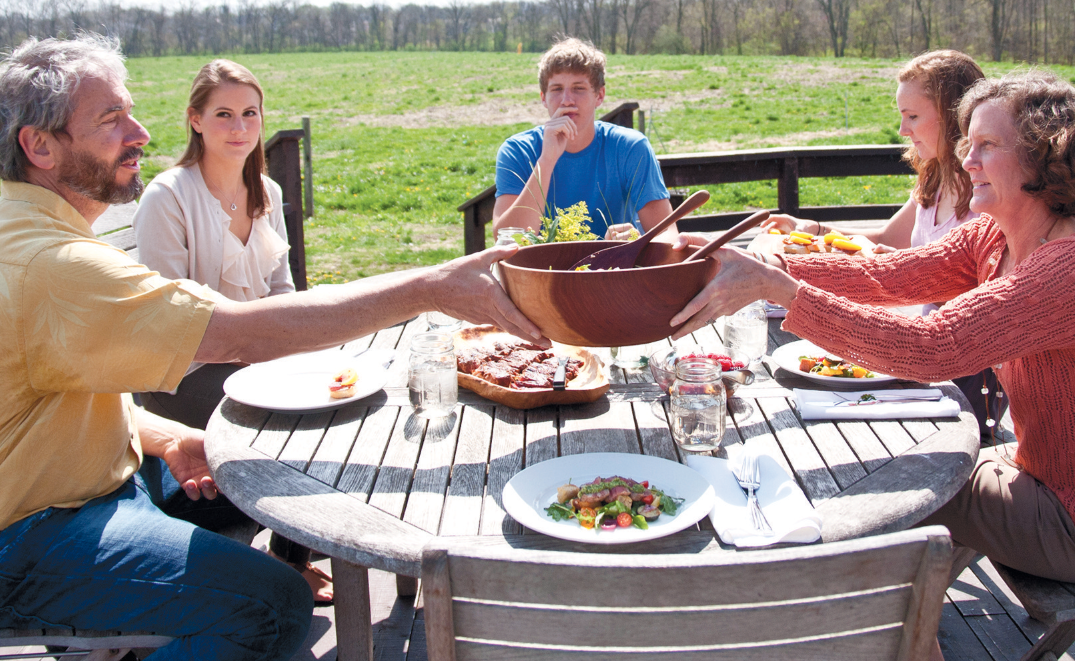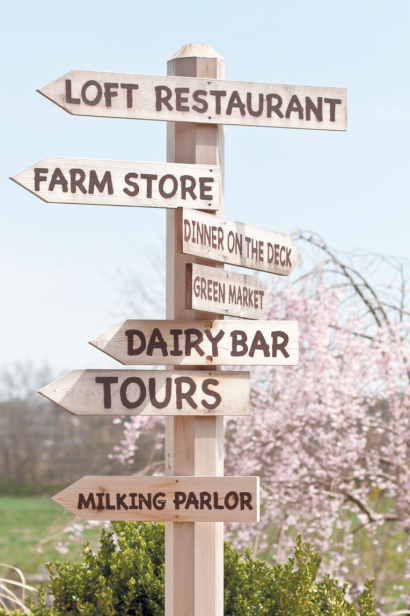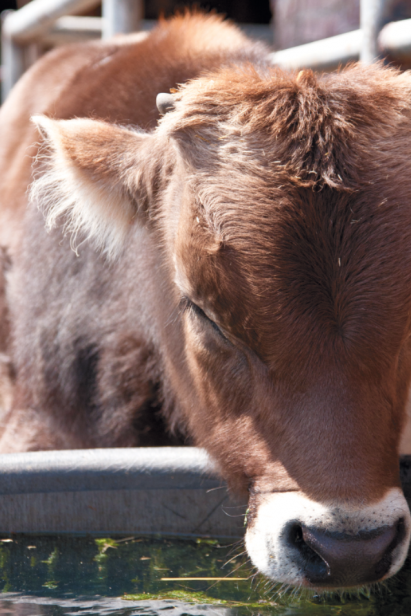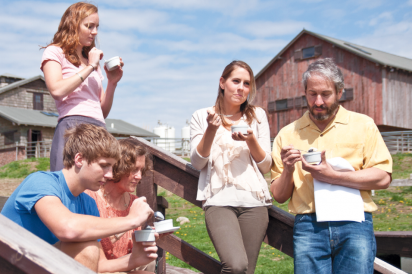At Traders Point Creamery, Farm-to-Table Is a Way of Life
The soil that supported the meal might be the last thing on most people's minds when they sit down to dinner. But thanks to the burgeoning farm-to-table movement, a growing number of Indy residents are reconnecting with the land in a deeper way–through the food they eat.
Nowhere is this connection more accessible than at Zionsville's Traders Point Creamery, the first organic dairy farm in the state specializing in grass-fed products.
"Farm-to-table is about reconnecting people who are not spending their day-to-day life on a farm with the source of their food," says Todd Jameson of Slow Food Indy and Balanced Harvest Farm. The Creamery, he says, is a terrific place to experience firsthand what a family-owned, sustainably farmed operation looks like–and to taste the fruits of the land.
Given the pace of modern life, it can be a revelation when people first drive down the lane to Traders Point Creamery and step out of their cars to find a working farm just minutes from the traffic of the city.
At the creamery, the cows that give the milk are a stone's throw from the restaurant serving the award-winning artisan cheeses made from that milk, as well as the farm's grass-fed beef, pastured chicken and eggs. Not to mention the luscious ice cream and yogurt. The weekly yearround farmers' market–the only one in the state–is in view of the working garden that provides much of the produce for the restaurant. Those hungry for more are invited to take a walking tour of the farm, watch the cows being milked, or schedule a guided nature hike on the 320-acre grounds.
The owners of the organic farm, Fritz and Jane Kunz, make summer guests welcome on the spacious deck during Friday night Green Markets, where there's always a band playing and an enticing dinner of local fare on offer. In the shadow of the 1800s barns that make up the Creamery's primary structures–all moved from sites in Bluffton and Geneva, Indiana–patrons leave the hustle of the week behind. Jane Kunz is likely to be found purchasing items for her own family's table from the market's many local farmers and artisans, in between greeting guests and old friends. Her husband is a gregarious sort, always eager to bend an ear about the perks of eating food originating from an actual farm instead of a factory.
"They say you are what you eat?" he might quip, looking out over the green pasture dotted with Brown Swiss cows, all intent on munching. "You are what they ate." And what they ate, he might say, is sunshine.
"All of us are trying to achieve a balanced immune system to fight the problems of civilization, like heart disease, and that balance is improved through ingesting 100% grass-fed products."
A Veritable Smorgasbord
The Kunzes are deeply committed to nurturing the land. Though they have 220 cows, they milk less than half of them at any one time and let the remainder of the herd rest. The milk of new mothers is strictly off-limits; their calves stay with them much longer than is standard in the industry. Best of all, the herd lives much of the year on pasture, eating the way cows evolved to eat.
Fritz Kunz, a physician, was introduced to the nutritional value of grass-fed meats and dairy by a woman his wife calls "our first customer," who sought them out while the enterprise was in its infancy. From that encounter, he became acquainted with the traditional foodways rediscovered by nutrition pioneer Dr. Weston A. Price, an advocate of nutrient-dense whole foods and animal fats.
Despite conventional wisdom about the supposed unhealthiness of the fat in whole milk and beef, Fritz Kunz found that grass-fed cattle actually produce meat and milk with health benefits on a par with a certain celebrated fish. The fat profile in whole milk from cows raised on pasture, he learned, closely mirrors the omega-3 levels in fresh wildcaught salmon.
Research has shown a host of protective health benefits from this type of fat, and its absence in the diet has been linked to diabetes, asthma and autoimmune disorders, he notes. "All of us are trying to achieve a balanced immune system to fight the problems of civilization, like heart disease," he says, "and that balance is improved through ingesting 100% grass-fed products."
When he says "grass," he's not talking about the kind of monoculture that graces the front lawns of America. The fields are actually planted with many different grasses and legumes, from alfalfa to various clovers to ryegrass. The fields are carefully protected. Every few weeks, the herd is rotated to new pasture to allow the grasses to recover. In colder months, the cattle shelter in the Red Hay Barn and are fed hay grown onsite.
Even as little as two coffee cans a day of grain in a cow's stomach can tip the balance to a detrimental fat profile, and possibly lead to adverse effects for the cow as well. The farm staff is well-schooled in the kind of vigilance it takes to maintain a herd on pasture. Only 100% grass-fed will do.
This despite the fact that a grain-fed cow can produce twice as much milk as her grassfed sister. And cows given recombinant bovine growth hormone, a common additive in conventional milk, make up to three times more milk. "We get precious little milk from each animal, but that milk is incredibly valuable in terms of its nutritional profile," says Fritz Kunz. "That's why we go to all this trouble to get you this product, and why we believe we're creating the healthiest product we can get."
He compares this way of farming to buying a Mercedes with the intention to "drive it forever," instead of running through cheaper models every few years. There's a distinct longterm payoff. "Over the course of the cow's lifetime, we get a lot of milk and we get a lot of calves from her."
A Farm's Origins
The complicated formulae involved in raising cattle were not even on the Kunzes' radar before 1997, when they inherited her grandmother's farm.
In the family since the 1950s, the land that was to become the Creamery had served as pastureland for a dairy a mile away, which was also owned by Jane Kunz's family. It was her grandma's last request that both plots stay in the family, and they did; a brother owns the farm down the road.
Jane Kunz recalls visiting her grandmother at least once a week throughout her childhood, and between the farm animals and the open land, it was an idyllic time. But she never envisioned herself taking on a farming enterprise. "We didn't know we'd inherit this piece. But we're happy to be able to carry the baton," she says.
Though organic practices were not in force in the dairy back then, it was not a stretch for the Kunzes to make that commitment. Jane Kunz cites her great-aunt, who lived almost to the age of 110, as an inspiration. "She had the only organic farm I knew of in the 1970s. That impressed me that she was on it already, back then."
With three young children, the Kunzes had already prioritized organic food on their table. But it was the surprise inheritance that spurred them to make organic practices their livelihood, and they soon began transitioning the farm to be a certified organic dairy.
Bringing Farm-to-Table Home
A significant part of the creamery's mission revolves around sharing the message of sustainably grown food and good nutrition with the community. A highlight of the impressive slate of educational programming? Day camps, where youngsters get a firsthand taste of farm life. For families, gardening workshops offer hands-on practice growing vegetables, with the working garden serving as a living example of what's possible at home.
But the Kunzes take it a step further, realizing that many people are so divorced from their food that they may not know how to cook from scratch, let alone to buy or prepare fresh produce from a farmers' market. A meal planning workshop can help demystify the process. On Friday nights throughout the early part of the summer, attendees can sample dishes like Gouda Vegetable Soup, then walk the Green Market with a nutrition expert, recipe in hand, shopping for the ingredients that make up a mouthwatering soup.
At the Kunzes' own meals, the watchword is local. And it doesn't get much more local. "Many nights we sit down to our table," says Jane Kunz, "and everything I'm looking at on our plate is from right here."
Asked what people can do to bring the farm-to-table ethos into their own meals at home, she laughs. "Fritz would say I like color. And I do. I want a colorful plate," she says. That's not only for the visual appeal, but for optimum nutrition: All that variety translates to nutrients.
Aside from color, planning a meal around the freshest and most delicious-looking produce at the farmers' market is one way to guarantee a fabulous dining experience. "Sometimes someone will offer to go to the market for me, and I say 'No way!' I've got to be able to look at the food and see what looks great," she says.
Once home with that fat vine-ripened tomato or tender eggplant, cooks should resist the temptation to add a lot of bells and whistles, she says. When the ingredients are top notch, less is more in terms of seasonings and sauces.
The same applies to quality protein. Says Fritz Kunz, "When you go to a restaurant and they've put sauces and all kinds of fancy stuff on your entrée, it's just an attempt to hide a sub-par protein. It's making a silk purse from a sow's ear." Bottom line? Go for simplicity, and let the ingredients shine on their own merits.
Flavors of Summer
To showcase the farm-to-table movement at its best, the couple recently sat down to a dinner of summer fare with their three children, Kamman, 16; Carey, 18; and Knubbe, 20. Conceived by culinary consultant Mark Shreve, the meal was inspired by tastes he encountered while traveling and living in Italy. Vibrant in color and contrasting in flavors, the menu offers flexibility to the summertime cook, says Shreve.
"For many farmers, the agricultural work is their form of art. They can share their experience and stories about the food you're about to eat, and it almost becomes poetic."
"If you have a CSA or a garden and you're looking for a new way to use your produce, a lot of these dishes can be adapted to whatever you have," he says. Grilled summer panzanella is particularly versatile, with its festive mix of high-season showstoppers–heirloom tomatoes, summer squash and peppers are standard, but any abundant vegetable at its peak of freshness will do.
Similarly, while the crostini appetizer calls for ripe peaches, and was adapted from an Italian version using melon, Shreve says cooks should choose whatever fruit is freshest and most tempting at the market. "Nothing's very exact in these recipes. That's the great thing about summertime, you can mix things up," he says.
The fruit, marinated in red wine vinegar and thyme for a sweet/sour note, adds a surprising tang to the salty prosciutto and smooth creamery cheese spread on the toasted baguette. The use of herbs throughout the meal, from starter to dessert, showcases the intense flavors of summer without overpowering the other ingredients.
"These recipes may seem complex, but they're actually quite simple to make," says Shreve. "Many of these things can be made ahead, because in summer the last thing you want to do is spend the day in the kitchen."
Nor do you want to dine inside: The best meals are eaten under the summer sky, ideally at the farmstead, says Slow Food Indy's Jameson. He agrees that simplicity is key. "Things do not have to be extravagant in order for you to have a gourmet meal." In fact, beyond the clean flavors, a farm-to-table dinner's appeal often lies in the story behind the food.
Farm-to-table proponents say that connecting with growers at a farmers' market or even during the meal enriches it. People begin to understand of the challenges, rhythms and beauty of a life spent raising food. "For many farmers," says Jameson, "the agricultural work is their form of art. They can share their experience and stories about the food you're about to eat, and it almost becomes poetic."
Telling those stories around the dinner table can raise a meal to new heights for guests and hosts alike.
Jameson is glad to see people rediscovering the joys of slower, quieter pastimes, with good food often central to these nourishing rituals. "In a down economy, all of a sudden, people are re-experiencing the benefits of a simpler life and spending more time with family and friends." The simple pleasure of being together around the table, with food that was lovingly prepared and sustainably raised, can create an unforgettable experience.
For his part, Shreve lauds the fact that the culinary priority of convenience is slowly being replaced with an awareness of the health, social and economic benefits of eating real food from closer to home. "There's an emotional benefit, too, as we support people who live nearby us," he says.
A rustic setting, a meal of just-picked produce and locally produced artisan foods and friends around the table. That's the recipe for a memorable summer evening.








